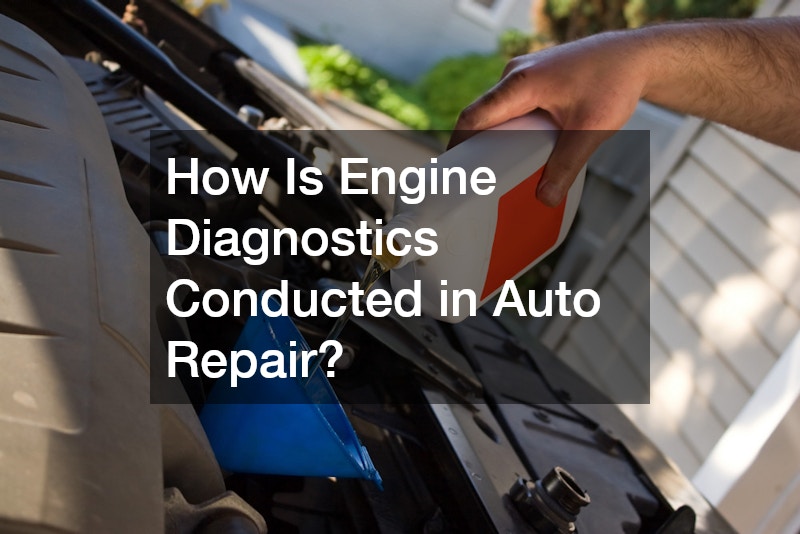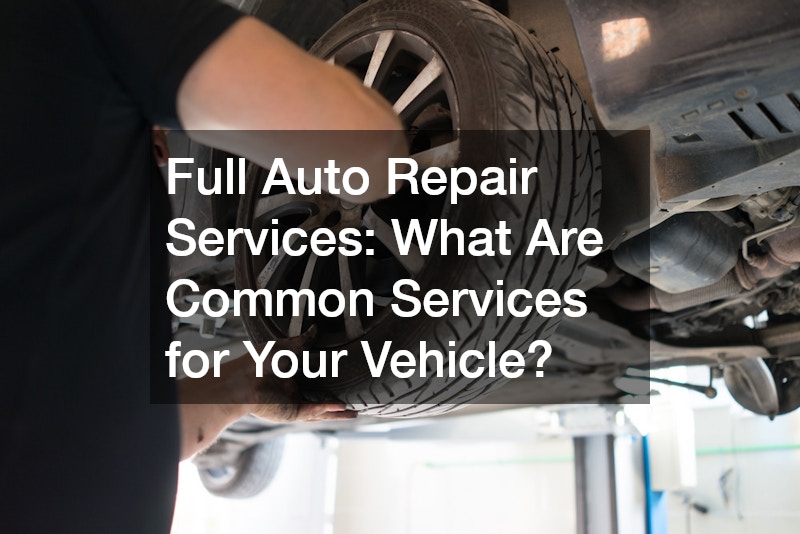Maintaining a vehicle is crucial for ensuring its longevity and performance. Full auto repair services encompass a range of essential maintenance and repair tasks that keep your car running smoothly. From car detailing and routine oil changes to complex transmission repairs, each service plays a vital role in the overall health of your vehicle. This article delves into the most common full auto repair services, highlighting their importance and what they typically involve. Understanding these services can empower car owners to make informed decisions about their vehicle’s maintenance and repair needs.
1. What Are the Basic Maintenance Services in Full Auto Repair?
1.1 Oil and Filter Changes
One of the most fundamental services offered at any auto repair shop is oil and filter changes. Regular oil changes are critical because engine oil lubricates the engine’s moving parts, reduces friction, and helps maintain optimal operating temperatures. Neglecting this service can lead to engine wear and costly transmission repairs. The frequency of oil changes may vary based on the vehicle’s make and model, but generally, it is advisable to change the oil every 5,000 to 7,500 miles.
1.2 Tire Rotation and Balancing
Tire rotation and balancing are also essential maintenance tasks. Regular tire rotation helps to promote even tire wear, enhancing the lifespan of your tires and improving safety. When tires are balanced, it ensures a smoother ride and better handling, reducing strain on the suspension system. Local auto repairs often include these services as part of a comprehensive maintenance schedule. Neglecting tire care can lead to uneven wear, affecting traction and performance.
1.3 Fluid Inspections and Top-offs
Fluid inspections and top-offs are integral to vehicle maintenance. Essential fluids include coolant, brake fluid, transmission fluid, and power steering fluid. During a routine service, a technician will check these fluids, looking for any leaks or signs of contamination. Regular fluid top-offs can prevent overheating and ensure the smooth operation of systems like brakes and steering. Auto body repair shops also recommend regular inspections to catch potential issues before they escalate into costly repairs.

2. How Is Engine Diagnostics Conducted in Auto Repair?
2.1 Use of Diagnostic Tools
Engine diagnostics is a critical service that helps identify underlying issues affecting vehicle performance. Modern auto repair facilities utilize advanced diagnostic tools that interface with the car’s onboard computer systems. These tools can read error codes and provide valuable information regarding engine performance. Early detection through diagnostics can save money in the long run by addressing minor problems before they develop into major transmission repairs.
2.2 Identifying Trouble Codes
When a vehicle’s Check Engine light illuminates, it signals the need for diagnostics. Technicians will connect a scanner to the vehicle, pulling trouble codes that indicate specific issues. These codes are vital for troubleshooting, guiding mechanics to the heart of the problem. By interpreting these codes accurately, they can recommend the appropriate repairs, whether it’s an electrical issue or a more severe engine malfunction that could potentially impact the transmission.
2.3 Interpreting Diagnostic Results
Once the trouble codes are retrieved, technicians will interpret the diagnostic results to develop a repair plan. This analysis often includes checking related systems that could contribute to the identified issue. For example, if a code indicates a malfunctioning sensor, the technician might also check the vehicle’s wiring and connectors. Thorough diagnostics help ensure that any necessary repairs, including brake repairs or auto glass replacements, are performed efficiently and effectively.
3. What Are the Signs You Need Brake Services?
3.1 Unusual Noises While Braking
Brakes are one of the most critical safety components of any vehicle. If you notice unusual noises while braking, such as squeaking or grinding, it’s a strong indicator that you need brake services. These sounds typically mean that brake pads are worn and need replacement. Ignoring these signs can lead to more severe damage, requiring more extensive repairs at an auto body repair shop.
3.2 Vibration Under Braking
Another common sign that your brakes may need attention is vibration when applying the brake pedal. This can indicate warped brake rotors, which can compromise your vehicle’s stopping power. Local auto repairs often address these issues promptly to ensure safety. A technician can assess whether the rotors can be resurfaced or if they require replacement, ensuring that your braking system functions properly.
3.3 Brake Warning Light Activation
The brake warning light on your dashboard is a crucial indicator of potential problems. If this light comes on, it could signify various issues, from low brake fluid to more severe braking system failures. It’s essential to take this warning seriously and seek professional brake repairs as soon as possible. Ignoring the warning could lead to dangerous situations on the road, making timely intervention critical for safety.
4. How Important Is Timing Belt Replacement?
4.1 Manufacturer Recommendations
Timing belt replacement is often outlined in the manufacturer’s maintenance schedule, usually between 60,000 and 100,000 miles. This critical component synchronizes the engine’s internal parts, ensuring they operate harmoniously. Failing to replace the timing belt as recommended can lead to catastrophic engine failure, necessitating expensive repairs or even engine replacement. Understanding the importance of adhering to these recommendations can save car owners from significant financial burdens down the road.
4.2 Symptoms of a Failing Timing Belt
Symptoms of a failing timing belt can include unusual noises coming from the engine, engine misfires, or oil leaks. If any of these signs are noticed, it’s crucial to have the vehicle examined by a professional. Waiting too long can lead to more severe issues, including the need for costly transmission repairs. Regular inspections and timely replacements of the timing belt can prevent such problems and keep your vehicle operating smoothly.
4.3 Consequences of Timing Belt Failure
The consequences of a timing belt failure are dire, often resulting in severe engine damage. When the belt breaks, the engine’s pistons can collide with the valves, causing significant damage. This kind of repair is not only costly but can also leave you without your vehicle for an extended period. To avoid these repercussions, regular maintenance and prompt timing belt replacement are vital for vehicle health and reliability.

5. What Suspension and Steering Services Are Offered?
5.1 Shock and Strut Replacement
Suspension plays a critical role in vehicle handling and comfort. Over time, shocks and struts can wear out, leading to a rough ride and poor handling. When you visit a local auto repair shop for suspension services, technicians may recommend shock and strut replacement to restore your vehicle’s stability. New shocks and struts can significantly enhance ride quality, making driving safer and more enjoyable.
5.2 Steering System Inspection
A thorough steering system inspection is essential for ensuring responsive handling. Technicians will check the power steering fluid levels, inspect the steering components, and test the system’s performance. If issues are detected, they can address them quickly, potentially preventing costly repairs in the future. Ensuring your steering system is functioning properly is crucial for maintaining control over your vehicle, especially in emergency situations.
5.3 Wheel Alignment Services
Wheel alignment is another vital service that affects tire wear and vehicle handling. Misaligned wheels can lead to uneven tire wear, resulting in the need for premature tire replacements. A qualified auto repair shop can perform precise wheel alignments, ensuring that your tires make proper contact with the road. Regular alignments can also improve fuel efficiency, making it a worthwhile investment for any vehicle owner.
6. How Are Electrical Systems Diagnosed in Auto Repair?
6.1 Battery and Charging System Tests
Electrical systems are integral to vehicle performance, and regular testing is essential. A technician will perform battery and charging system tests to ensure your vehicle starts reliably. If you experience issues with starting your car, these tests can identify whether the problem lies with the battery, alternator, or other electrical components. Addressing these issues early can prevent being stranded and the need for costly repairs.
6.2 Alternator and Starter Checks
In addition to battery tests, technicians will also check the alternator and starter system. A malfunctioning alternator can lead to battery drain, while a faulty starter can leave you unable to start your vehicle. Regular inspections of these systems can help ensure that you won’t encounter unexpected breakdowns. Identifying and fixing electrical issues promptly is a key aspect of maintaining vehicle reliability.
6.3 Addressing Wiring and Connector Issues
Wiring and connector issues can also pose significant challenges in vehicle electrical systems. Corroded connectors or damaged wiring can lead to various problems, from dashboard lights malfunctioning to failure of critical systems. Skilled technicians will inspect these components during a routine service, ensuring that all connections are secure and functioning correctly. Prompt repairs can save you from more extensive issues down the road, including those that may require auto body repairs.

7. Why Are Full Transmission Services Necessary?
7.1 Fluid Replacement and Flushing
Full transmission services are essential to maintaining your vehicle’s transmission system. Regular fluid replacement and flushing help to keep the transmission clean and operating efficiently. Dirty or low transmission fluid can lead to slipping gears and erratic shifting, ultimately necessitating costly transmission repairs. Following the manufacturer’s guidelines for transmission service intervals can help prevent serious issues and prolong the life of your vehicle.
7.2 Transmission Filter Replacement
In addition to fluid changes, replacing the transmission filter is crucial for optimal performance. The filter helps to remove contaminants from the transmission fluid, ensuring that the system remains clean. Clogged filters can lead to poor transmission performance and increased wear on internal components. Regular maintenance that includes filter replacement can significantly enhance your vehicle’s overall functionality and reliability.
7.3 Transmission Rebuild and Repair
In cases where transmission issues arise, a full rebuild or repair may be necessary. This process can be extensive, often involving disassembly of the transmission to replace worn or damaged parts. Skilled technicians at an auto repair shop will assess the situation and recommend the best course of action. Timely intervention can prevent more severe damage and help you avoid the significant costs associated with complete transmission replacement.
8. What Are Common Cooling System Services?
8.1 Radiator and Hose Inspection
The cooling system is vital for preventing engine overheating, and regular inspections are essential. Technicians will check the radiator for leaks and assess the condition of the hoses. Worn or cracked hoses can lead to coolant leaks, compromising the system’s efficiency. Routine inspections can help detect these issues early, preventing potential engine damage and costly repairs.
8.2 Thermostat and Water Pump Replacement
In addition to inspecting the radiator and hoses, the thermostat and water pump should also be evaluated regularly. The thermostat regulates the engine’s temperature, while the water pump circulates coolant throughout the system. If either component fails, it can lead to overheating and engine damage. Local auto repairs often include these services as part of a comprehensive cooling system check, ensuring optimal performance.
8.3 Coolant Flush and Replacement
Performing a coolant flush and replacement is another crucial aspect of cooling system maintenance. Over time, coolant can become contaminated and less effective at regulating temperature. Flushing the system removes old coolant and debris, allowing fresh coolant to circulate. This service not only enhances engine performance but also prevents overheating and extends the life of your vehicle.
9. How Are Exhaust System Issues Addressed?
9.1 Exhaust Leak Detection
Exhaust system issues can significantly impact vehicle performance and emissions. Technicians will perform exhaust leak detection during routine inspections to identify any leaks in the system. These leaks can lead to decreased fuel efficiency and increased emissions, making it essential to address them promptly. Catching exhaust issues early can prevent more extensive damage and ensure your vehicle runs efficiently.
9.2 Muffler and Exhaust Pipe Repair
Muffler and exhaust pipe repairs are common services in auto repair shops. A damaged muffler can result in increased noise levels and decreased performance. Similarly, a compromised exhaust pipe can lead to exhaust leaks and poor engine efficiency. Skilled technicians can quickly assess and repair these components, restoring your vehicle’s performance and compliance with emissions regulations.
9.3 Catalytic Converter Replacement
The catalytic converter plays a crucial role in reducing harmful emissions, and its failure can lead to significant environmental impact and potential legal issues. If the catalytic converter is malfunctioning, it will likely need replacement. Auto repair specialists will conduct tests to determine if a replacement is necessary, ensuring that your vehicle remains compliant with emissions testing regulations.

10. What Services Are Included in AC and Heating Repair?
10.1 Refrigerant Recharge
Maintaining a comfortable cabin environment is essential, making AC and heating repair crucial. One common service is refrigerant recharge, which replenishes the cooling agent in your AC system. Over time, refrigerant levels can drop, leading to decreased cooling performance. Regular recharges ensure that your AC system operates efficiently, enhancing comfort during hot weather.
10.2 Heater Core Inspection
The heater core is vital for heating the cabin during colder months. If you notice a lack of warm air or foggy windows, it might be time for a heater core inspection. Technicians will assess the core for blockages or leaks, ensuring that your vehicle’s heating system functions properly. Addressing these issues promptly can enhance comfort and visibility during winter driving conditions.
10.3 Blower Motor and Resistor Checks
The blower motor and resistor are critical components of your vehicle’s HVAC system. If the blower motor fails, you won’t get any airflow through the vents. Similarly, a faulty resistor can cause inconsistent blower speeds. Regular inspections of these components can identify issues early, allowing for timely repairs that keep your heating and cooling systems functioning optimally.
Conclusion
While services like auto tinting and paint jobs are fun, there are necessary maintenance tasks that you need to be aware of. By being proactive and seeking local auto repairs when necessary, you can ensure that your vehicle remains reliable and safe for years to come. Knowledge of these services empowers you as a vehicle owner, enabling you to make informed decisions that contribute to your vehicle’s overall health and performance.

